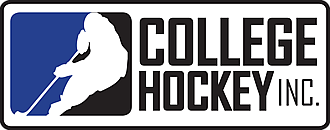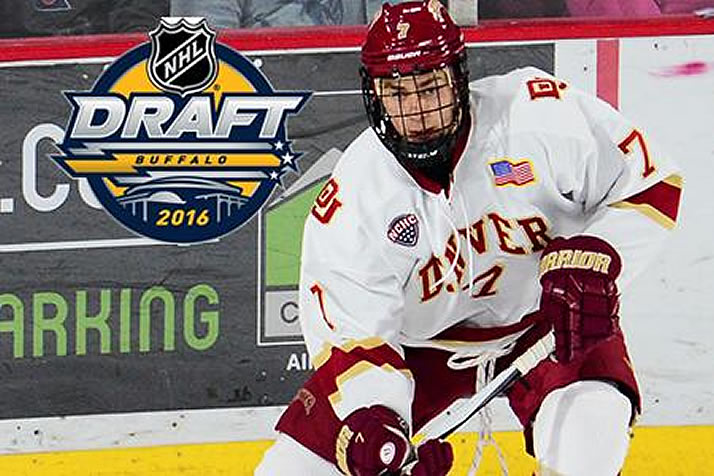


Approximately five dozen current and future NCAA players will be selected in the NHL Draft June 24-25 in Buffalo, N.Y.
A small subset of those – likely between six and 10 – will be players who spent their draft year playing college hockey.
Recent history suggests that those selections may be the best values in the draft.
Related: 2016 NCAA Draft Guide (.pdf)
College Hockey Inc. conducted a study of the first nine drafts since 2005, when the draft was reduced to seven rounds. In that period 86 players have been taken after spending their draft season in the NCAA.
Of those players, a remarkable 56% reached the NHL for at least one game and 37% have appeared in at least half a season (41 GP). Those figures are 13 and 10 percentage points higher, respectively, than all other players in the draft.
Players drafted out of the NCAA have not just reached the NHL, but made a significant impact. NHL rookie sensations Shayne Gostisbehere, Jack Eichel and Noah Hanifin were all selected after their freshmen year, as were Stanley Cup finalists Justin Braun, Matt Nieto and Tommy Wingels of the San Jose Sharks.

Older Competition
Most NHL draftees are 18 years old and the average age of an NCAA freshman is near 20, so there are relatively few draft-eligible players in the NCAA each year.
Those who are, however, get to compete against older players – some as old as 24 or 25. That gives scouts a chance to evaluate prospects against opposing players who are closer, physically, to what those prospects would face in the NHL.
Last year – before a record three current college players were taken in the top nine picks of the draft – TSN’s Craig Button explained why that was beneficial.
“One of the biggest things watching players at 17 or 18 is that you are trying to project what they will be like as an NHL player,” said Button, former Calgary Flames general manager. “You don’t get to see them play at that level – no sport does. But for Eichel, Hanifin and Werenski, you get to measure these players against bigger and stronger players who are closer to the NHL game. In my view there’s nothing but positives in that regard.”
Related: See ISS Hockey's Top 5 NCAA Players
“It can tell you a lot,” agreed ISS Director of Scouting Dennis MacInnis. “You can’t see players against NHL competition, but seeing players in college does show you how they stack up against more physically mature opposition.”

Beyond the First Round
Success in the NHL Draft is vastly more unpredictable beyond the first round. While 92% of all first rounders will reach the NHL, only 34% of players taken after the first round can say the same.
Last year three current NCAA players went in the first nine picks, and three more should go in the first round this year. But most current NCAA players in the draft are taken after the first round – and that may be where the biggest values lie.
Players like Gostisbehere, Braun and Wingels were all taken out of the NCAA ranks after the first round, as were Paul Stastny and Alec Martinez.
Luke Kunin, Charlie McAvoy and Tage Thompson are likely to hear their names called on Friday night of the draft in Buffalo. While they may develop into stars, NHL teams can expect to find solid future contributors among the likes of Dylan Gambrell (Denver), Chase Priskie (Quinnipiac) and Rhett Gardner (North Dakota) on Saturday.
 The Age Factor
The Age Factor
Many of the NCAA players taken in the draft are a year – or even two – older than the majority of players taken. That may account for some of their success relative to other draftees. While NHL teams tend to favor taking players in their first year of draft eligibility – they have an additional year to fulfill their potential – a second-year eligible player may show something at the college level that wasn’t clear in junior hockey.
Such was the case for Gostisbehere, whose slight frame when he was headed to Union had teams wondering if his offensive gifts would shine through against NCAA competition. After they did, the Philadelphia Flyers grabbed him in the third round.
Gambrell, undrafted as a Dubuque Fighting Saint in 2015, recorded 47 points in 41 games while helping lead Denver to the Frozen Four as a freshman. At 19, he is a year older than most 2016 draft picks, so scouts may have a clearer picture of the player he will eventually become.
“Those years are such big development years, one year can make a huge difference,” ISS Hockey’s MacInnis said. “I’ve seen a guy one fall who has been 5-foot-11 and by the next year he’s shot up to 6-2 and is a whole different player.”
NHL scouts, like MacInnis, never stop watching for the next impact player. Now more than ever, they are finding them in the college ranks.